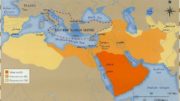
(for more indepth understanding of Islam, see Virginia Christian Alliance advisor, Dan Wolf’s 13 part series by clicking HERE)
Fortress of Faith Radio by Tom Wallace and Shahram Hadian, and today’s program: The History of Islam. Below are simple SHOW NOTES and prone to typos. So, Listen to the program HERE ( OR DOWLOAD THE MP3 HERE)
But the other of love, knowing that I am set for the defence of the gospel. (Philippians 1:17)
We, as Christians, need to stand up and defend what we believe in. Our goal at Fortress of Faith is to defend our faith from the onslaught of the religion of Islam. Islam claims that our Scriptures have been corrupted and they have the superior religion and the superior scriptures.
My background is that of a foreign missionary, and Shahram’s background is that of a former Muslim who is now a Christian pastor.
Today we are going to try to cover 1,400 years of Islamic history. We are going to pick up our look at Islam’s history at Muhammad’s death. He died in the year 632 AD.
The Rashidun (Righteous) (Mecca, Saudi Arabi) Caliphs 632-661
Immediately after the death of Muhammad there was a disagreement about his successor so there was a vote taken to determine who it would be. Muhammad had claimed that he was “the final prophet.” The decision was made to make Muhammad’s father-in-law, Abu Bakr, the first caliph (successor). They could not find a blood relative because Muhammad’s sons had not survived to this time. Abu Bakr was the father if Aisha, Muhammad’s child wife.
Abu Bakr only governed for 2 years, 632-634. It was a very politically violent rule. After the death of Muhammad, Islam was splintering because, from it inception, Islam functioned in a political-military fashion. Many had been converted by the sword and were trying to leave Islam. Bakr, as a righteous caliph, was to unite Islam again. History tells us that thousands of people were killed because they were apostates. The number of those killed was as high as 40 to 50 thousand during the two year reign of Abu Bakr.
After Abu Bakr’s death, we have the second Rashidun caliph, Umar. He was also related to Muhammad as the father of another of Muhammad’s wives. Under his rule there is a real spread of Islam outside of the Arabian peninsula into Syria and Persia (Iran).
Umar spread Islam outside of Arabia and started taking the lands of Christians. Syria, a very strong Christian nation, was the first target. Muhammad was very familiar with Syria because in his early years he was involved in caravan trading with them. This is where he was exposed to a lot of Christian teaching.
In Chapter 9, the last chapter of the Qur’an, Muhammad gave a financial solution for Islam. Muhammad’s final words had nothing to do with a salvation message like that of our Lord. His final words were how to live off the backs of the Christians and Jews. He taught them to get Christians and Jews to pay the Jizya, a tax for protection from Muslims. They could take 50% of what Christians and Jews owned, and 50% of what they earned.
This is called dhimmitude. We can’t quite call this slavery, but it is only one step away. They became second class citizens. They had three choices, become a Muslim, submit to dhimmitude, or die.
At the time of Umar the Persian Empire was not what it had been. It was easily taken by Umar, and the Persians hated Umar for doing so. He was assassinated by a Persian. It was a way of getting back at him. It didn’t help in getting rid of Islam, but it did give some satisfaction.
Umar was followed by Uthman. He was assassinated also. Uthman was caliph from 644 to 656. We see that the caliphs did not last very long. Uthman was also connected to Muhammad as the husband of one of Muhammad’s daughters.
Under Uthman, Islam was still advancing into North Africa, and there was a turn toward Europe. Again, Islam was advanced by the sword.
One of the primary accomplishments of Uthman was the writing and publishing of the Qur’an. In one battle, many of the reciters of the Qur’an were killed, and Uthman felt they could lose the Qur’an if it were not written down. He ordered 4 copies to be made, and Islam claims that 2 of them are still existence today. We have covered in previous articles that this is not true. There is evidence that these copies were written much later.
Uthman was assassinated in his house. This is where we see the beginning of the split between the Sunni Muslims and the Shi’ite Muslims.
The 4th caliph was Ali reigned from 656 to 661. Ali was the cousin of Muhammad, and was the first caliph who was a blood relative of Muhammad. This is the main difference between the Sunni and the Shi’ite Muslims. The Shi’ite Muslims believe the caliph must be a blood relative of Muhammad. The first 3 were not blood relatives of Muhammad, they were related through marriage. Not only was Ali a blood relative of Muhammad, he was also married to one of Muhammad’s daughters, Fatima.
During his reign we see the expansion into Kuffa, which is in Iraq today. Ali was also assassinated during a time of prayer as retaliation for the assassination of Uthman. The Shi’ite Muslims assassinated Uthman, and the Sunni Muslims assassinated Ali, and this has been happening every since. This is the end of the Rashidun period of Islamic History.
The Nature Of Islam
We call Islam a religion, but historically we see it is more of a political-military movement. We see this when we study the caliphates (empires) of Islam.
Before we get into the next period, I want to go back to Muhammad’s migration to Medina. Not only did the character of Islam change at that time, there was also a change of the calendar. The Islamic calendar is not the same as ours. We are in 2016, but on the Muslim calendar it is 1438. Their calendar begins in our year 622. Our calendar uses the abbreviation AD to indicate Ano Domini, the year of our Lord. The Muslim calendar uses AH for Ano Hijra (migration), the year of the migration.
Today we are 578 years apart, but since our calendar is based on the solar year, and the Muslim calendar is based on the lunar year, the gap is closing. The lunar year is about 11 days shorter than the solar year. The calendars will agree in the year 2860.
We are not talking about religious history, we are talking about a history of conquest. We are not talking about religious leaders, we are talking about rulers and kingdoms. It is important that we understand that Muhammad was not just building a religion, he was building an empire.
The Umaayyad Caliphate (Damascus, Syria) 661 – 750 (41AH)
During this period they move the headquarters of Islam from Arabia to Damascus in Syria. Remember, before Islam conquered Syria, it was the largest Christian nation on earth. Today Syria is only about 10% Christian.
Islam expanded by conquest, and they were conquering non-Arabs. They moved into Persia (Iran), India, and North Africa.
The founder of the Umaayyad Caliphate was Abu Sufyan from Mecca. One of the desires of this caliphate was to restore a true Arabic culture within Islam. I think this is one of the hidden differences between the Sunni Muslims and th Shi’ite Muslims. I think there is a lesser than attitude that makes Arab Muslims more pure, and all other Muslims lesser.
This caliphate ran from 661 to about 750, but I believe the death blow came in 732. We will talk about this later.
When they established Damascus as the headquarters of the Islamic government, they made Arabic the official language of the government, and all of the coinage. Again, we are not talking about a religion, we’re talking about a government with its own money. The goal of this caliphate is to bring some unity by bringing it back to an Arabic Islam.
They had expanded all the way across Northern Africa. They then turned to Europe. They invaded and conquered Spain. From Spain they started to expand into France. Thank God for a leader named Charles Martel (Charles the Hammer). In 732, Martel stopped the advance of the Islamic armies. This was the beginning of driving them out of Europe. This is why I believe that the Battle of Poitiers, also called the battle of Tours, in 732 was the beginning of the end of this caliphate.
Within 100 years after Muhammad, Islam had expanded all the way into France. This never would have happened with only conversions to Islam. It only happened because of the military-governmental sword behind the expansion. All of those who are talking about the peaceful history of Islam are not looking at its true history. Islam’s history is one of bloodshed and war, leaving a wake of dead bodies in its path.
During this time we also see the versions of the Qur’an developed. They claim that they go back to the time of Muhammad, but the evidence shows that they are really of more recent origin.
Would you consider supporting this ministry on a monthly basis?
You can do so by going to our donation page




